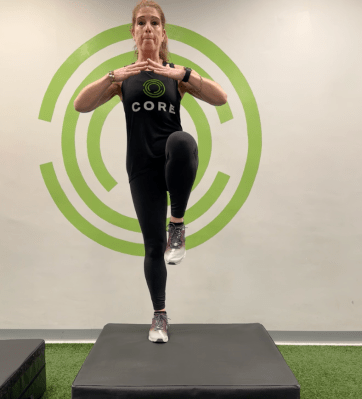Step-Ups Are Secretly One of the Best Glute Moves You Can Do. Here’s How
Your backside will *love* them.

When it comes to functional strength training, some of the best exercises are the ones that carry over directly into your real-life movements. (Think: squats, which help you stand up from sitting on the toilet, and push-ups, which help you press yourself up and out of bed.)
Step-ups are another perfect example. Every time you walk up a flight of stairs, hike up a hill, step up into an SUV, or even get up from kneeling, you’re doing a version of a step-up.
Step-ups are such a good indicator of physical fitness that researchers use step-ups to gauge leg muscle strength and leg function, especially in older adults, like in this 2011 study in BMC Musculoskeletal Disorders.
To train your body to better handle this movement, all you need to do is incorporate step-ups as a strength exercise in your fitness routine.
“We do a ton of step-ups at my studio for all different reasons,” says Denise Chakoian, CPT, certified personal trainer and founder of Core Studios in Providence, Rhode Island. The move benefits everyone from elite athletes to those looking to stay mobile and independent late in life.
That said, step-ups can be intimidating if you try to go too high too fast, or you’re working on your balance. Here’s how to do step-ups correctly, the benefits they offer (hint: your glutes are going to love them), and how to level up as you get stronger— because there are some step-up variations that really burn.
How to do a step-up the right way
Step-ups are a really diverse move, Chakoian says, with near infinite ways to perform them. This simple, intermediate version could be considered the core version of the step-up—but we’ve outlined more variations below.

- Stand facing a sturdy plyo box, bench, or step that’s at about knee height.
- Lift your right foot and place it on top of the box directly in front of your right hip, making sure it’s a few inches away from the edge and your toes are pointing straight forward.
- Keeping your torso upright, press your weight into your right foot and push through your quads and glutes to straighten your right leg and stand on it on top of the box.
- At the same time, drive your left knee up to hip height, so your left thigh is parallel to the ground.
- Reverse the move, lowering your left foot to the floor with control. Step your right foot down to the floor next to your left.
- Do 12 to 15 reps, then repeat on the other side.
The ideal step-up height will be highly variable depending on what equipment you have available, your own height, mobility, and fitness level.
Chakoian says she typically sets up clients with a platform that allows their knee to be bent at 90 degrees and directly in line with the ankle in the starting position. However, beginners may find it best to start lower, and advanced exercisers may want to challenge their mobility and strength by doing step-ups even higher.
Muscles worked by step-ups
Step-ups are a functional-strength leg-day superstar. “Step-ups primarily work your glutes and quads,” explains physical therapist and strength coach Schuyler Archambault, DPT, CSCS. “Your glutes work to extend your hip, and your quads work to extend your knee.”
The secondary muscles step-ups work are your hamstrings (which help to extend your hips), hip abductors and adductors (which maintain knee stability), and your calves (which help with ankle stability), Archambault says. Step-ups also call on your lower abs and pelvic floor in order to stabilize your pelvis, Chakoian adds.
The step height you’re working with also changes how the move activates your muscles. “With a higher step height, you will need to lean your body forward more. This will cause an increase in hamstring activation to help the glutes extend the hip,” Archambault explains.
The benefits of step-ups
Step-ups come with a lot of benefits that extend to other sports activities—like running or playing pickleball—as well as remaining an efficient mover in day-to-day life.
1. Stronger glutes
Step-ups may be especially great for growing your glutes. A 2020 research review published in the Journal of Sports Science & Medicine found that step-ups were the best lower-body move for targeting the gluteus maximus (the largest butt muscle) compared to other common lower-body exercises including hip thrusts, squats, deadlifts, and lunges.
Not only did classic step-ups show the highest gluteus maximus activation, but three other step-up variations measured came in second, third, and fourth, above every other type of move.
2. Better stability and coordination
Some of the most impressive benefits of step-ups come from the fact that they’re unilateral exercises: They work one side of your body at a time. As a result, they’re great for improving balance, stability, and coordination, Archambault says.
Specifically, step-ups drill pelvis and core stabilization due to their single-sided nature, she says. This stability is important because it helps keep your hips from dropping to one side when running or walking, for example.
Better balance can also help you avoid falls or injuries. “I work a lot of single-leg moves, pretty much with every client. It doesn’t matter how well they are,” Chakoian says. “The benefit is you learn how to really engage the core, and if you should happen to fall, you’ll be stronger than if you did not do any single-leg training.”
3. Better sports performance
Improved stability, coordination, and single-leg strength are key for people who do sports of any kind, whether tennis or rollerblading.
Namely, step-ups help with any activities that ask you to move forward, back, and laterally (side to side), Chakoian says. Step-ups also help train your fast-twitch muscles for power-based activities like sprinting, she says.
4. Addresses muscle imbalances
Typically, if you’re doing bilateral (or two-legged) training all the time—moves like squats, deadlifts, or hip thrusts where your two legs are contributing equally—you’re going to create a muscle imbalance because you’re likely favoring your dominant side, Chakoian says.
“We just don’t realize, but we all do it.” The two sides of your body will likely never be perfectly equal, but if you work on your single-leg strength, you can make sure you’re adequately building muscle on both sides.
5. Improved cardio
Step-ups are also an aerobic activity when performed at higher volume (i.e., more reps) and are great for getting your heart rate up, Archambault says.
This can come in handy for conditioning workouts, HIIT, or when you’re trying to knock out strength and cardio in one go.
Every time you walk up a flight of stairs, hike up a hill, step up into an SUV, or even get up from kneeling, you’re doing a version of a step-up.
Step-up variations to add to your routine
There are so many ways to do step-ups, and the good news is that they all come with the above cardio, strength, and stability benefits. Try these step-up variations from Chakoian and Archambault, listed in order of increasing difficulty.
1. Up-up-down-down step-up
If you have a lower step, are a beginner, or are looking to gain more cardio from step-ups, try this version from Chakoian. She loves doing this move as a dynamic warm-up for more advanced athletes who may tackle weighted step-ups later in a workout.
- Stand facing a sturdy box, bench, or step that’s at about knee height or lower.
- Lift your right foot and place it on top of the box directly in front of your right hip, making sure it’s a few inches away from the edge and your toes are pointing straight forward.
- Keeping your torso upright, press your weight into your right foot and push through your quads and glutes to straighten your right leg and stand on it on top of the box.
- Step your left foot onto the box next to your right.
- Step your left foot down to the floor, then step your right foot down to the floor.
- Repeat, starting with the left foot. Alternate the starting foot for each rep. Repeat for 1 minute.
2. Weighted step-up
If you want to really work on strength with this move, hold onto a dumbbell in each hand and perform step-ups slowly, with an emphasis on challenging your leg strength rather than getting breathless.
“Think about keeping your upper body tall with your shoulders back, especially if you are holding weight,” Archambault says.
- Stand facing a sturdy box, bench, or step that’s at about knee height, holding a light- to medium-weight dumbbell in each hand by your sides.
- Lift your right foot and place it on top of the box directly in front of your right hip, making sure it’s a few inches away from the edge and your toes are pointing straight forward.
- Keeping your torso upright, press your weight into your right foot and push through your quads and glutes to straighten your right leg and stand on it on top of the box.
- Step your left foot up to tap the box.
- Step your left foot down to the floor. Keep your right foot on the box.
- Do 10 to 12 reps, then repeat on the other side.
3. Lateral step-up
Lateral step-ups are great for increasing the amount of lateral hip activation (such as the gluteus medius and minimus), Archambault says.
- Stand to the left of a sturdy box, bench, or step that’s at about knee height, with your feet parallel to the side of the box.
- Lift your right foot and place it next to you on top of the box, making sure your foot is a few inches away from the edge and parallel to the side of the box. Your knee should be over your ankle.
- Keeping your torso upright, press your weight into your right foot and push through your quads and glutes to straighten your right leg and stand on it on top of the box.
- Drive the left knee up to hip height.
- Reverse the move, lowering your left foot to the floor with control. Step your right foot down to the floor next to your left.
- Do 10 to 12 reps on the right side before turning in the opposite direction to repeat on the left.
4. Step-down
Eccentric training (strength training that focuses on the downward portion of a movement) can be a really great way to challenge yourself with just your body weight or feel a different effect from a move you’re already familiar with.
“Step-downs are great for working on knee and hip control,” Archambault says. For advanced athletes, Chakoian loves to lower on a three-count and then add a quick, one-count knee drive to press back up to the starting position.
- Stand facing a sturdy box, bench, or step that’s about knee height.
- Lift your right foot and place it on top of the box directly in front of your right hip, making sure it’s a few inches away from the edge and your toes are pointing forward.
- Straighten your right leg to stand on top of the box. Allow your left foot to hang off the back of the box. This is your starting position.
- Take three counts to lower your left foot to the floor, slowly bending your right knee and keeping your torso as upright as possible and trying not to let your knee move from side to side.
- Once your left foot is on the ground, press back up to stand on the right leg to return to the starting position.
- Do 10 to 12 reps, then repeat on the other side.
Common step-up mistakes and how to fix them
Step-ups are humbling. Don’t be afraid to drop the weights or pick a shorter step to start, so you can get your form on point. “I see a lot of people struggling to get up on one leg because it is challenging, even for someone that works out a lot,” Chakoian says.
A big mistake she sees is people leaning too far forward, sliding their knee forward over their foot on the working leg. This puts a lot of stress on the knee, and also takes away from the work the glute should be doing, she says. Similarly, you shouldn’t feel the need to hunch forward to get up—that could be a sign that the step is too high.
If you’re doing a knee drive at the top of the move, don’t thrust your hips forward or tuck your pelvis under, she adds. Keep your core engaged but your spine and pelvis neutral.
Archambault also notes you should “work on making sure your knee is moving straight forward and not caving in as you step up and down. Make sure to have your weight distributed evenly through the foot; it helps to think about pushing through your heel on the way up so you are not on your toes,” she says.
Safety tips for step-ups
It’s a good idea to do start by doing step-ups onto a shorter surface and then progressing to higher platforms from there, Archambault says. She also recommends starting without weight and gradually building up when you feel confident in the movement.
When Chakoian works with clients who are beginners or new to step-ups, she spots them and offers her hand for safety in case they lose their balance. However, if you’re on your own, she recommends moving the step or box over to a wall or doorway and performing the exercise with the wall to your side. This way, you can use the wall for support whether you’re tipping forward or backward.
If you feel any pain while performing step-ups, stop doing the move, and consider consulting a physical therapist or trainer for help.
FAQ
1. What can I use for step-ups at home?
An actual step—whether it’s the first one or two steps in a staircase or the step on your front porch—is a great option, especially for beginners because it’ll be low and very stable. If you’d like to step up higher, you may be able to use a bench, chair, table, or even an ottoman.
The most important factor is that whatever you’re stepping up on is stable and won’t tip over when you place your weight onto one side. Be sure to test furniture within reach of a spotter or wall, just in case.
2. How can I do step-ups as a beginner?
If you’re a beginner or have limited mobility, you can start with a step that’s between 6 and 12 inches, Chakoian says. (In a gym, try using an aerobic step, and at home, a single stair.) Use Chakoian’s above up-up-down-down step-up variation. Try repeating for 40 seconds, resting for 20, and then repeating 3 or 4 times.
If you’re new to step-ups or trying to step higher, it’s also a good idea to set up next to a wall or door frame that you can hold onto for support, Archambault adds.
3. How many sets and reps of step-ups should I do?
Chakoian loves doing step-ups for time, especially when doing the up-up-down-down version as part of a warm-up. Try repeating for 40 to 60 seconds, resting for 20 to 30 seconds in between sets.
If you’re doing step-ups for strength work or reps, she recommends doing 12-15 reps—the last three reps should feel really challenging, she says.
You can do anywhere from one set (during a warm-up) to 2 to 3 sets (for targeted strength work) to 4 sets (perhaps in a cardio-strength circuit workout).
What's Your Reaction?








![How to Understand & Calculate Statistical Significance [+ Example]](https://www.hubspot.com/hubfs/how-to-calculate-statistical-significance-1-20250106-7754856.webp)






























.png)












































